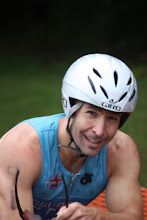Mission accomplished.
My third Ironman finish was a charm, setting a new personal best time of 11:52:13 on a tough weather day. I was able to focus my thoughts like never before and apply lessons learned from my first two finishes and my painful 2008 DNF.
·
The swim and first 86 miles on the bike felt
easy. The real work started at the turn around in Ausable Forks as we faced a
strong headwind on the final 26 miles of climbing. The positive spirit among
athletes pretty much dried up as we all started battling our inner demons.
·
I never felt “good” between mile 86 of the bike
and mile 18 of the run. The crowds and my family and friends gave me energy,
but I really hadn’t ever experienced such a long dark period. Somehow I was able
to stay focused on the moment and respond to my immediate needs and
surroundings.
·
Around mile 14 of the run my friend Ryan jogged
beside me for a few strides. He was fired up, telling me how “rock solid” I
looked and complimenting me on my bike ride. I wasn’t able to muster much of a
response other than a puzzled look. Couldn’t he see my suffering?
·
I survived on Coke, chicken broth, and water on
the second run loop. I think making that nutritional adjustment saved my day.
·
I started to feel better after the final
turnaround on River Road, and knew by the 20-mile marker that I had a personal
record in the bag. I decided not to push too hard from that point forward.
Instead I soaked up the crowds and enjoyed being immersed in the Ironman
experience. My final 10K was a victory dance.
·
There’s no experience like that Olympic speed
skating oval finish. What a homecoming!
Beating my 2007 Lake Placid finish by a little over 13
minutes might not seem like a major accomplishment to the casual observer. But it was a proven difficult weather day compared to 2007. The scuttlebutt is that
the average AG’er finished 29 minutes slower in 2012 than 2011.
Consider this; I improved my final position by 181 places
compared to 2007 despite having 300 more athletes in the field in 2012. In 2007 I finished
in the top 27% of the smaller starting field. This year I finished in the top
16%. I’m definitely getting closer to achieving my Ironman potential, but
there’s still plenty of room for improvement.
I haven't made plans for races beyond this year, but the allure of pursuing excellence in this ultimate one-day event is undeniable. I simply love it.





